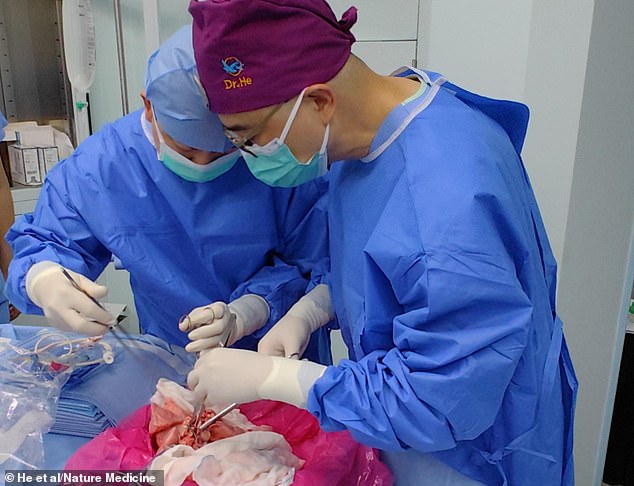Surgeons have successfully transplanted a pig lung into a human, marking another huge step in the decades-long quest to use animal organs for life-saving procedures.
In the first operation of its kind, the genetically modified pig lung was transplanted into a 39-year-old brain-dead male following a brain haemorrhage.
Amazingly, the organ remained ‘viable’ and functional over a period of nine days – suggesting humans could one day live with transplanted pig lungs.
The scientists, from the Guangzhou Medical University in China, say their work is the first documented instance of cross-species lung transplantation.
‘Genetically engineered pig lungs have not previously been transplanted into humans,’ say the scientists.
‘[Our study shows] pig lungs can maintain viability and functionality in brain-dead recipients for 216 hours.’
Humans have survived before for short periods with implanted pig hearts and kidneys – but never pig lungs.
However, as it stands, humans living healthy lives with transplanted pig lungs could still be decades away.

The genetically modified pig lung remained viable and functional over a period of nine days. Pictured, dissection of surrounding tissues from the trachea


The remarkable procedure, detailed in a new paper published in Nature Medicine, ‘demonstrates the feasibility of pig-to-human lung xenotransplantation’
The study represents a significant step for ‘xenotransplantation’, which involves transplanting organs from one species into another.
Previous studies have demonstrated the feasibility of transplanting kidneys, hearts and livers from gene-edited pigs into humans.
However, the transplantation of lungs is a much bigger challenge, due to their fragility, complexity and exposure to toxins from air in the outside world.
As a result, the team had to make gene edits to a Chinese Bama Xiang pig whose left lung they obtained.
Gene editing tool CRISPR was used to remove the antigens that could activate the human immune system following the transplantation.
CRISPR, an innovative but controversial technique, makes precise cuts in DNA and then harnesses natural DNA repair processes to modify the gene in the desired manner.
Next, the lung was transplanted into the human recipient who had been declared brain-dead – and therefore considered officially deceased.
A person who is brain-dead is legally confirmed as dead, even if a life support machine keeps their heart beating and their lungs inhaling air.

The left lung from a gene-edited donor pig was ‘xenotransplanted’ into a brain-dead human recipient

CRISPR, an innovative but controversial technique, allows scientists to rewrite the genetic code in almost any organism. It makes precise cuts in DNA and then harnesses natural DNA repair processes to modify the gene in the desired manner
The experts found that the lung was not immediately rejected by the immune system and maintained ‘viability and functionality’ over the course of nine days.
However, they observed signs of lung damage at 24 hours after transplantation and signs of ‘antibody-mediated rejection’ (AMR) of the lung at days three and six after transplantation.
As a result of AMR – where the recipient’s immune system makes antibodies that target their transplanted organ – the experiment was terminated on day nine.
Nevertheless, the remarkable procedure, detailed in a new paper published in Nature Medicine, ‘demonstrates the feasibility of pig-to-human lung xenotransplantation’, the team say.
The results also demonstrate how xenotransplantation could address the worldwide organ shortage crisis.
Promisingly, pigs are very similar to humans in terms of anatomy, so the species is used generally as a model for developing new treatments.
However, substantial challenges relating to lung rejection and infection remain, the team caution in their new paper.
The high blood flow and external air exposure of the lung makes it particularly susceptible to immune attack, where a body’s immune system reacts too strongly to invaders.

Chest radiographs at the indicated times after transplantation -the experiment was terminated at day nine
Read More
Major breakthrough as 10 patients have their diabetes CURED with new drug

Future studies will refine lung xenotransplantation and move closer to ‘clinical translation’ involving live people who need a lung transplant.
‘This study provides crucial insights into the immune, physiological and genetic barriers that must be overcome, and paves the way for further innovations in the field,’ the team conclude.
‘Continued efforts are needed to optimise immunosuppressive regimens, refine genetic modifications, enhance lung preservation strategies and assess long-term graft function.’
The study comes just months after Alabama woman Towana Looney became the longest-living recipient of a pig organ transplant, surviving 60 days with a gene-edited pig kidney.
In April, she’d had the kidney for more than four months but it was removed when the organ suddenly stopped functioning, Science reported.
